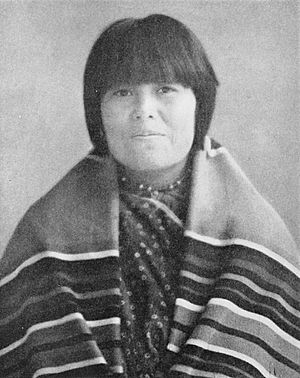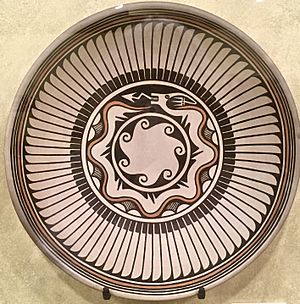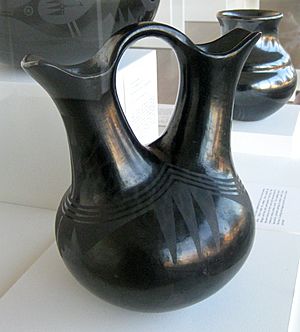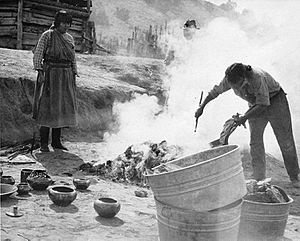Maria Martinez facts for kids
Quick facts for kids
Maria Montoya Martinez
|
|
|---|---|
| Po've'ka | |

Martinez c. 1925
|
|
| Born |
Maria Poveka Montoya
1887 |
| Died | 1980 (aged 92-93) San Ildefonso Pueblo, New Mexico
|
| Nationality | American |
| Known for | Pottery, Ceramics |
| Movement | San Ildefonso School |
| Spouse(s) | Julian Martinez |
Maria Montoya Martinez (1887 – July 20, 1980) was a famous Native American artist. She created beautiful pottery that is known all over the world. Maria, her husband Julian, and their family worked together. They studied old Pueblo pottery styles and techniques. This helped them create new pieces that showed the rich art history of the Pueblo people.
Maria Martinez's pottery, especially her shiny black pots, can be seen in many museums. These include the Smithsonian, the Metropolitan Museum of Art, and the Denver Art Museum. The Penn Museum in Philadelphia has several of her pots. Some are signed "Marie" or "Marie & Julian."
Maria grew up in the San Ildefonso Pueblo. This community is about 20 miles northwest of Santa Fe, New Mexico. She learned pottery skills from her aunt at a young age. She remembered "learning by seeing" when she was about eleven. She watched her aunt, grandmother, and father's cousin make pottery in the 1890s. At that time, metal pots from Spain and enamelware from Anglo settlers became common. This meant people didn't need traditional clay pots as much. But Maria and her family experimented with old techniques. They helped keep this important cultural art alive.
Contents
Early Life and Learning
Maria was born in San Ildefonso Pueblo, New Mexico. Her parents were Tomas and Reyes Pena Montoya. She had four sisters: Maximiliana, Juanita, Desideria, and Clara. Maria was the middle child. Her aunt, Nicolasa, taught her how to work with clay. All five sisters made pottery, and some of their work is in exhibits today. Maria once shared that she saw an alien on a mountain when she was eight years old. Her native name, Po've'ka, means "pond lily" or "water lily" in the Tewa language.
Rediscovering Ancient Pottery
In 1908, an archaeologist named Edgar Lee Hewett led an excavation. He was a professor and the director of the Museum of New Mexico. During this dig, they found pieces of old black-on-white pottery called "biscuit ware." These broken pieces were found in the sandy, red clay of the New Mexico desert.
Some people mistakenly thought that black pottery stopped being made around the late 1700s. They believed plant pigments replaced glazed pottery. However, the nearby people of Santa Clara Pueblo had been making shiny black pottery since the 1600s. This pottery was known for its highly burnished (polished) surface.
Hewett wanted to find a skilled Pueblo potter who could recreate the ancient biscuit ware. He planned to put these new pots in museums to preserve the old art form. Maria Martinez was known in the Tewa pueblo of San Ildefonso for making the thinnest pots very quickly. So, Hewett thought she was the perfect person to bring his idea to life.
It's important to know that Maria and her husband also created a new style. This was matte black designs on polished blackware. This unique style was different from the ancient biscuit ware. It was something they developed on their own.
Making Black Pottery: A Challenge

Creating the black-on-black pottery style was a long and difficult process. Maria had to experiment a lot to meet her high standards. One big challenge was making the clay turn black. Most clay found in the hills is not naturally jet black.
Maria learned from the Tafoya family of Santa Clara Pueblo. They still used traditional pottery methods. She saw that if you smothered the fire around the pottery during outdoor firing, smoke would get trapped. This smoke would then turn the clay different shades of black.
She tried an idea where a polished red pot, painted with a red slip, was fired in a "smudging fire." This fire was kept at a cooler temperature. The goal was to get a deep, shiny black background with dull black designs. They used broken pottery pieces and sheep or horse manure around the outdoor kiva-style adobe oven. This helped give the pot a slicker, matte finish.
After many tries, Maria finally made a successful black ware pot. The first pots for a museum were fired around 1913. These early pots were plain, unsigned, and a bit rough. The first public display of this pottery was in July 1920 at the New Mexico Museum of Art.
At first, Maria was embarrassed that her black pots weren't as perfect as the ancient ones. She even hid them away. A few years later, Hewett and his guests visited her pueblo. These guests wanted to buy black ware pottery, like the ones in the museum. This interest greatly encouraged Maria. She then worked hard to perfect her black ware art. Her skills improved with every pot. Her art became very popular with collectors and grew into a successful business. Maria also started trying new techniques to make other shapes and colorful pottery.
What Black Ware Pottery Looks Like

An olla jar is a type of pot with a slightly flat rim and a distinct angle at the shoulder. The one made by Maria and Julian Martinez is typical of this style. It has decorations only on the rims, above the shoulder angle.
The surface of these pots is shiny and smooth, reflecting light. The jet-black ceramic looks perfect. A band of lighter black decoration stands out against a solid black matte background. This type of pot uses only the surface finish for its decorative effect. It makes the designs look like they are scratched into the pot.
A wide-eyed avanyu, or horned serpent, often wraps around the pot. It slithers within the decorated band. The serpent's tongue almost touches its tail. The snake's movements seem alive. This shows how much the Pueblo people appreciate nature and life. The decorations give each pot its own special look and personality.
The Pottery Making Process
Making black ware pottery is a long process. It takes many steps and requires a lot of patience and skill. There are six main steps before a pot is finished. According to Susan Peterson, these steps are: "finding and collecting the clay, forming a pot, scraping and sanding the pot to remove surface irregularities, applying the iron-bearing slip and burnishing it to a high sheen with a smooth stone, decorating the pot with another slip, and firing the pot."
The first step is gathering the clay. This is usually done once a year, in October, when the clay is dry. The clay is then stored in a special adobe building where the temperature stays the same.
Next, it's time to mold the clay into a pot. The right amount of clay is brought into the house. It's placed on a cloth-covered table. A fist-sized hole is made in the clay. Equal amounts of gray-pink and blue sand are put into this hole. A smaller hole is made in the blue sand, and water is poured in. All these ingredients are then kneaded together. The mixture is wrapped in the cloth, washed, and covered with a towel to keep it moist. The clay then dries slightly for a day or two to become stable.
Maria used a "puki," which is a supporting mold made of dry or fired clay. This mold helps form the round bottom of a new pot into a pancake-like shape. After squeezing the clay with her fingers, a 1-inch high wall is pinched up from this base. A gourd rib is used in criss-cross motions to smooth out the wall, making it thick and even. Long coils of clay are then added to the top of the wall. These coils are smoothed out with the gourd, making the pot taller. Any air holes are filled with clay and sealed with the gourd rib.
After drying, the pot is scraped, sanded, and polished with stones. This part takes the most time. A small, round stone is rubbed on the side of the pot in steady, horizontal, rhythmic motions. The pot is polished by rubbing the stone parallel to its side. This creates a shiny, evenly polished surface. The pot is then ready for firing after a second layer of slip (a liquid clay mixture) is applied. This slip is painted onto the polished surface in various traditional designs.
Firing the Pottery
Maria Martinez used a special firing method called "reduction firing." This happens when the air around the pots doesn't have enough oxygen for the flames. This causes a chemical change that makes the clay turn dark. The firing process took many hours, on top of weeks of preparation. Maria was often helped by her husband or children. They would fire the pots early in the morning on a clear, calm day, so the wind wouldn't cause problems.
First, the pots were placed in a firing pit. They were carefully covered with broken pieces of pottery and metal sheets. Small gaps were left for air to keep the fire burning. The pit was then surrounded with very dry cow dung, which was used as fuel. The dung was placed carefully to keep the air vents open. The goal was to prevent any flames from actually touching the pots, which is why the metal sheets were used.
After covering the kiln (oven) with more cow dung, they lit the kindling on all sides. This made sure the heat spread evenly. They kept adding dry cedar wood to the fire until it reached about 1,200 to 1,400 degrees Fahrenheit. The exact temperature depended on the look they wanted for the pots. If the fire kept burning, the pottery would turn a red-brown color. But to make the famous blackware pottery, the fire was smothered with dry, powdered horse dung. This greatly reduced the oxygen inside the kiln. This "reduction atmosphere" caused the pots to turn black. After several hours, Martinez moved the horse dung to put out the fire. She then buried the pots so they could cool slowly. Once the pit kiln was cool enough, they carefully removed the pots. They used a stick if the pots were still hot, or their hands if they were cool enough to touch.
Adding Decorations
Julian Martinez, Maria's husband, started decorating her pots after many attempts. To create his designs, he used a mixture of clay and water called "slip." He applied this to the polished, but unfired, surface of the pot. He found that painting designs with a mixture of guaco juice and clay created a matte design on a shiny background. The process involved polishing the background first, then painting the matte designs before firing.
In 1918, Julian finished the first of Maria's blackware pots with a matte background and a polished Avanyu design. Many of Julian's decorations were patterns taken from ancient Pueblo pots. These patterns included birds, roadrunner tracks, rain, feathers, clouds, mountains, and zigzags or kiva steps.
Signatures on Pottery
Maria used different signatures on her pots throughout her life. These signatures help us know when a piece of art was made. Maria and Julian's earliest works were not signed at all. They didn't know their art would become so popular and didn't think it was necessary to sign it. These unsigned pieces were likely made between 1918 and 1923.
Once Maria's pottery became successful, she started signing her work as "Marie." She thought the name "Marie" sounded more appealing to people outside the Pueblo culture than "Maria." Pieces signed "Marie" were made between 1923 and 1925. Even though Julian decorated the pots, only Maria signed them at first. This was because pottery was traditionally seen as a woman's job in the Pueblo. Maria respected this custom until 1925. After that, "Marie + Julian" became the official signature on all their pottery until Julian's death in 1943.
After Julian passed away, Maria's family began helping with the pottery business. From 1943 to 1954, her son Adam and his wife Santana worked with Maria. Adam took over his father's jobs of collecting clay and painting decorations. The new signature on the pots became "Marie + Santana."
Later, when her son Popovi Da started working with her, Maria began using her native name "Maria" on the pottery. They started signing their pieces together around 1956 as "Maria+Poveka" and "Maria/Popovi."
Maria won many awards for her pottery. She showed her work at several world fairs. In 1973, she received the first grant from the National Endowment for the Arts to fund a pottery workshop. Maria shared her knowledge and skills with many people. This included her family, other women in the pueblo, and students from outside. When she was young, she learned by watching her aunt. She learned a lot from Sarafina Tafoya of Santa Clara Pueblo. In 1932, the government Indian school in Santa Fe asked her to teach. Maria refused, saying, "I come and I work and they can watch." She believed that nobody truly "teaches" art; people learn by observing.
Honors and Recognition
Maria Martinez received special honorary doctorates from the University of Colorado and the University of New Mexico. A famous American sculptor named Malvina Hoffman created a portrait of her. In 1978, Martinez had a major solo exhibition at the Renwick Gallery of the Smithsonian Institution.
Collections
- Brooklyn Museum
- Cincinnati Art Museum
- Cleveland Museum of Art
- Crocker Art Museum
- Denver Art Museum
- Everson Museum of Art
- Gilcrease Museum
- Institute of Texan Cultures
- Jesse Peter Multicultural Museum
- Millicent Rogers Museum
- Minneapolis Institute of Art
- Museum of Fine Arts, Boston
- Museum of Fine Arts, St. Petersburg
- Museum of Modern Art
- National Museum of the American Indian
- National Museum of Women in the Arts
- Portland Art Museum
- Smithsonian American Art Museum
- Toledo Museum of Art
- University of Michigan Museum of Art
See also
 In Spanish: María Martínez (artista) para niños
In Spanish: María Martínez (artista) para niños
- List of indigenous artists of the Americas
- List of Native American artists
- Native American pottery
- American Museum of Ceramic Art Her artworks has been exhibited and are a part of the Permanent Collection
- San Ildefonso Self-Taught Group
- Black-on-black ware



